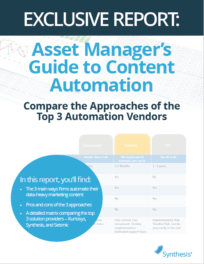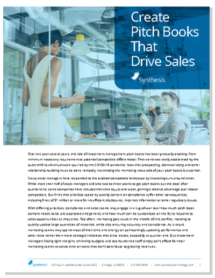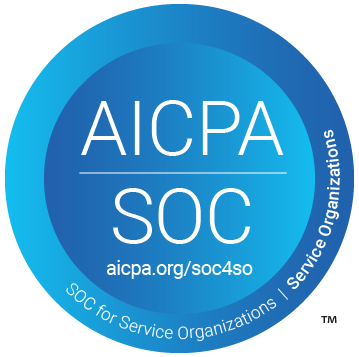The Growing Importance of ADA Compliance for Investment Companies

The asset management industry stands at a pivotal crossroads where inclusivity and accessibility are not just niceties but necessities.
The growing importance of ADA (Americans with Disabilities Act) compliant investment marketing materials is a testament to the industry’s commitment to serving a diverse clientele, and also to the evolving regulatory environment in which they operate.
Around 20 million Americans (8% of the population) live with some level of visual impairment. ADA compatibility helps ensure that individuals with disabilities have equal access to financial resources and services, which is crucial in fostering an inclusive economy.
The disabled communities in America actively judge, with their feet and their wallets, whether businesses are supportive or dismissive of their needs. Being seen as inclusive of the needs of the visually disabled can be a notable competitive advantage to many businesses, including the asset management industry. <
ADA Compliance for Investment Funds: A Competitive Differentiator for Asset Managers
ADA compatibility is becoming a requirement and a competitive differentiator in the asset management industry.
As digital documents and platforms become the primary means of client communication, ensuring that websites, mobile apps, and online PDF documents comply with ADA standards is not only a legal requirement but also a moral imperative. Asset managers are increasingly recognizing that ADA-compliant materials can significantly enhance user experience for all clients, including those with disabilities. This shift towards accessibility is not merely about avoiding litigation; it’s about building trust, expanding reach, and demonstrating social responsibility.
Moreover, firms that proactively embrace these standards are seen as forward-thinking and client centric. They understand that accessibility enhances usability for everyone, not just those with disabilities. By implementing ADA guidelines, asset managers can improve navigation, readability, and overall engagement with their literature, leading to better client retention and acquisition. Almost as importantly, they can also reduce the risks of lawsuits and fines related to lack of ADA compatibility.
Taking Steps to Produce ADA Compliant Fund Factsheets and Websites
If you’re in marketing operations at an investment management firm but haven’t already implemented ADA tagging as part of your workflow, you’re likely considering it (for the myriad of reasons we touched on above).
To get started creating ADA compliant PDFs and websites, Asset managers can take several practical steps to enable and ensure ADA compatibility.
1 – Understand ADA Regulations
First, asset managers should familiarize themselves with the ADA Standards for Accessible Design and regularly update their knowledge of ADA regulations, including Section 508 and the WCAG 2.0/2.1 guidelines.
Section 508 requires federal agencies to make their electronic and information technology (such as websites and online documents) accessible to people with disabilities. If you’re working with or for government agencies, compliance with Section 508 is mandatory.
In order for a website or document to be considered ADA compliant, it must be designed to support assistive technology such as screen readers, braille displays, and magnification software. More specifically, the ADA requires websites and PDF documents to comply with the WCAG 2.0/2.1 guidelines.
WCAG is the primary standard for web accessibility. WCAG 2.1, in particular, is widely adopted and includes criteria that are crucial for creating accessible digital content. Ensure your websites and digital documents meet at least WCAG 2.1 Level AA compliance, which is the most commonly required standard.
2 – Do your research
Asset managers can benefit from consulting with experts in ADA compliance and even individuals with disabilities to gain insights into how to improve accessibility. Engaging with the community can provide valuable feedback and help asset managers understand the practical needs of their clients.
3 – Conduct an Audit of Your Marketing Communications
Once you understand the guidelines for compliance, conducting an accessibility audit of digital assets, such as websites, online documents like fund factsheets and commentaries, and multimedia content, is crucial. This audit will identify potential barriers that may prevent individuals with disabilities from accessing your information and services. It will also help you create a list of materials that need to be made accessible and how. This could involve redesigning literature or website interfaces, providing alternative text for images, adjusting color pallets, ensuring that electronic documents are screen-reader friendly, and/or offering materials in versions customized for visually impaired clients.
4 – Establish Training and Ongoing Maintenance
Training staff in ADA compliance and the importance of an inclusive workplace culture is also vital. Employees should be aware of the various ways in which they can assist clients with disabilities and understand the legal and ethical reasons for ADA compliance. Additionally, asset managers should establish clear policies and procedures for ADA compliance and communicate these to all employees. This ensures that everyone in the organization understands their role in maintaining accessibility standards. As technology and client needs evolve, so should the measures taken to ensure ADA compatibility. This might include updating software, revising content, and staying informed about new accessibility tools and practices.
Using Automation to Create ADA Compliant Factsheets & Websites
ADA compatibility is often seen as yet another requirement and potential barrier to getting timely marketing communications out to investors and advisors. But it doesn’t have to be a hindrance to the quarter-end process.
To create efficiencies, asset management firms can leverage automation to make ADA tagging a seamless part of their content production.
It’s important to note, however, that the vendors and systems used to produce and update investment marketing content have different capabilities and limitations.
Some content automation or publishing tools may be able to generate appropriate tagging natively. Others may require remediation after publishing to add tags.
For example, the Synthesis Publisher content automation solution is natively ADA compliant and includes several best-in-class features in this category. In other words, the ADA features come “out of the box”, and do not require additional time, effort, or cost to implement.
The Future of ADA Compliant Investment Marketing is NOW
The integration of ADA compatibility into the asset management industry’s marketing materials is a clear indicator of the sector’s evolution. It reflects a broader societal push towards inclusivity and equality, ensuring that financial empowerment is accessible to all. Going forward, ADA compatibility will remain a key focus, shaping the future of asset management and reinforcing its role in building a more inclusive financial landscape.
Many firms now consider ADA Compliance to be a required feature of content automation systems that create accessible factsheets, commentaries, and website content at scale. As the industry continues to innovate, investment firms can’t risk implementing technology that doesn’t allow for ADA tagging as part of the overall solution.
For more detailed guidance, asset managers can refer to these resources on ADA compliance.
Additional Resources
- For more information on the ADA, visit https://www.ada.gov/ada_intro.htm
- Web Content Accessibility Guidelines (WCAG) Overview: https://www.w3.org/WAI/standards-guidelines/wcag/
- PDF/UA in a Nutshell: https://www.pdfa.org/resource/pdfua-in-a-nutshell/
- Accessibility Compliance Checklists – HHS: https://www.hhs.gov/web/section-508/accessibility-checklists/index.html
- The official Section 508 government website: www.section508.gov
- WebAIM – an excellent resource for all aspects of PDF accessibility: www.webaim.org
If you enjoyed this post and would like to keep up with this topic, please subscribe to our blog.
Here are some related resources that might interest you: From the Blog: The SEC’s New Modern Marketing Rule: Are You Prepared to Comply? |  From the Blog: Pitchbook Problems? 3 Ways Technology Can Help |  From the Blog: Four Ways Asset Management Marketers Can Grow AUM |




 Compare the Top 3 Finserv Content Automation Vendors [White paper]
Compare the Top 3 Finserv Content Automation Vendors [White paper] Create Pitchbooks the Drive Sales [White paper]
Create Pitchbooks the Drive Sales [White paper] Build vs. Buy: Should Your Financial Services Firm Outsource or Insource Marketing Technology? [White paper]
Build vs. Buy: Should Your Financial Services Firm Outsource or Insource Marketing Technology? [White paper]  10 Tips for Rebranding your Fund Marketing Documents [White paper]
10 Tips for Rebranding your Fund Marketing Documents [White paper]




